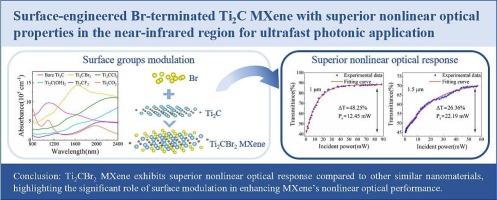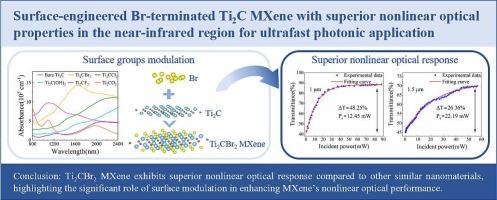Surface-engineered Br-terminated Ti2C MXene with superior nonlinear optical properties in the near-infrared region for ultrafast photonic applications
IF 6.9
2区 材料科学
Q2 CHEMISTRY, PHYSICAL
引用次数: 0
Abstract
MXenes have recently garnered tremendous interest as emerging optoelectronic device materials due to their remarkable optical and electronic properties. However, the uncontrollable nature of surface termination seriously hinders the development of MXenes. Therefore, surface functionalization of MXenes is crucial to optimize their performance. In this study, Ti2C MXene with Br group modification (Ti2CBr2) was synthesized, and its nonlinear optical properties for near-infrared (NIR) ultrafast photonic applications were investigated. Theoretically, first-principles calculations revealed the optical and electronic properties of bare Ti2C and Ti2CT2 (T = −Br, −Cl, –OH, −F, and −O). The results showed that Ti2CBr2 exhibited a superior optical response in the NIR band compared to the other termination adsorptions. Experimentally, Ti2CBr2 displayed large modulation depths of 48.25 % at 1 µm and 26.36 % at 1.5 µm, confirming its outstanding saturable absorption properties than many common nanomaterials. Furthermore, stable NIR mode-locking operation utilizing the Ti2CBr2 SA was achieved at 1030 nm and 1563 nm, respectively. This work not only demonstrates the significant promise of Ti2CBr2 in the field of ultrafast photonics but emphasizes the importance of surface functionalization modulation of MXene.


表面工程的br端接Ti2C MXene在近红外区域具有优越的非线性光学特性,可用于超快光子应用
MXenes作为一种新兴的光电器件材料,由于其卓越的光学和电子性能,近年来引起了人们的极大兴趣。然而,表面终止的不可控性严重阻碍了MXenes的发展。因此,MXenes的表面功能化是优化其性能的关键。本研究合成了带有Br基团修饰的Ti2C MXene (Ti2CBr2),并研究了其非线性光学性质在近红外(NIR)超快光子中的应用。理论上,第一性原理计算揭示了裸Ti2C和Ti2CT2 (T = - Br, - Cl, -OH, - F和- O)的光学和电子性质。结果表明,Ti2CBr2在近红外波段表现出较好的光学响应。实验结果表明,Ti2CBr2在1 µm处的调制深度为48.25 %,在1.5 µm处的调制深度为26.36 %,与许多普通纳米材料相比,Ti2CBr2具有出色的饱和吸收性能。此外,利用Ti2CBr2 SA分别在1030 nm和1563 nm处实现了稳定的近红外锁模操作。这项工作不仅证明了Ti2CBr2在超快光子学领域的重大前景,而且强调了MXene表面功能化调制的重要性。
本文章由计算机程序翻译,如有差异,请以英文原文为准。
求助全文
约1分钟内获得全文
求助全文
来源期刊

Applied Surface Science
工程技术-材料科学:膜
CiteScore
12.50
自引率
7.50%
发文量
3393
审稿时长
67 days
期刊介绍:
Applied Surface Science covers topics contributing to a better understanding of surfaces, interfaces, nanostructures and their applications. The journal is concerned with scientific research on the atomic and molecular level of material properties determined with specific surface analytical techniques and/or computational methods, as well as the processing of such structures.
 求助内容:
求助内容: 应助结果提醒方式:
应助结果提醒方式:


